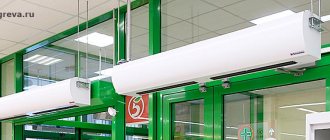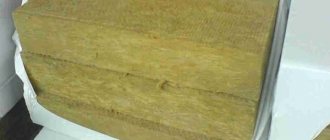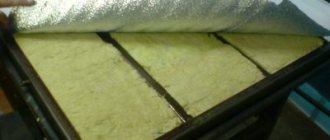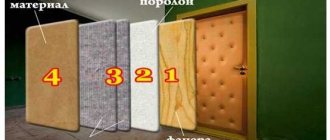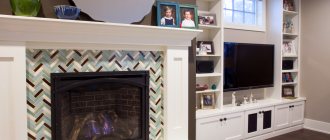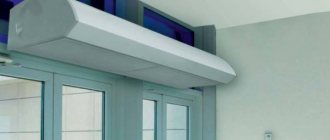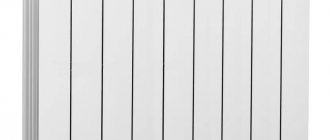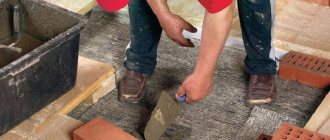Today, the thermal curtain is already a fairly common and popular heating device in many shops, garages, service stations, office buildings and other premises.
If you decide to install such a device, but have not yet decided which model to choose, let’s take a closer look at all the questions about the varieties and characteristics of individual types.
We will find out why they are needed in the first place and at the end we will list the main mistakes that you should avoid when purchasing and installing this unit.
Thermal curtain - what is it?
First of all, remember that the curtain is an additional, not the main heating device. Its main task is to create an invisible barrier from a powerful air flow.
Thanks to this, in winter, cold air simply cannot penetrate into the room through door or window openings.
Where is it required? Of course, not at home, but where doors are frequently opened and closed - shops, car repair shops, supermarkets, schools, etc.
However, sometimes there are owners of private houses who want to install such devices at the entrance to the house, for example, instead of a second door. Thus forming a kind of vestibule. Or in general, immediately at the entrance.
We do not recommend doing this, as this thing is quite noisy and will irritate you greatly.
Such devices are relevant for the purpose of energy saving in large heated rooms with poor thermal insulation. A curtain installed in the right place will help to some extent eliminate the main cold bridges and no longer flood the street.
You can find out which wall or opening loses the most heat using a thermal imager.
By the way, thermal curtains work not only in winter, but also in summer.
In the summer, cutting off the air flow from them will help keep the coolness inside the building created by air conditioners.
Trouble-shooting
Problems often arise with fan installations. If this functionality does not work, then you should check the electrical wiring, the presence of voltage in the network, the motor of the fan itself and the correct operation of the control devices. By the way, in order to protect the system from such situations, it is important to install a thermal curtain with reliable insulation of the supply cable.
Standard insulation may not be enough, so it would be a good idea to immerse the wire in a protective corrugated pipe. And also, if a leak appears in the water system, then the water supply infrastructure is checked and its tightness is subsequently restored. Most problems arise precisely because of disruptions in communication channels.
Principle of operation
How does it all work? This equipment operates in a similar way to a heat fan.
Air flows both here and there pass through the heating element.
Of course, there are models without heating. But in winter they create the feeling of an additional draft and unwittingly repel buyers and guests who come to your building.
The main difference between a curtain and a blower is the narrow directionality of the air flow - strictly along the plane of the openings where the equipment is installed.
This creates a powerful air barrier for outside air. This can be demonstrated on a temperature diagram.
The first figure shows a diagram of the distribution of air flows with a heater in the room, but without a curtain.
On the second, a curtain was placed in the area of the door and measurements were taken again. Take a look at the differences.
The scope of application of such devices is very large, ranging from small grocery stores to large warehouses and production workshops.
In summer, in addition to keeping you cool, the curtains also protect against the penetration of dust, annoying poplar fluff, exhaust gases and other unpleasant odors from the street.
Suddenly, not far from your building, there is a sewerage system or a trash can is located. This unit will also save you from all this. So its functionality is not limited by thermal effects.
System management
Typically, curtains are equipped with panels with hardware or touch control and remote controls, through which you can also adjust the operating mode of the equipment. Typically, devices have several operating modes that provide different throughputs. The main controlled element of the system is the fan - through a panel or remote control, for example, you can set the optimal speed of its rotation.
If a thermal curtain is installed using a water coolant, then the control capabilities should be calculated in advance, since they are provided by the structural elements. In particular, the use of the remote control will be possible only if a mixing unit, valve and thermostat are optionally included in the infrastructure.
Types and differences
What is the fundamental difference between some models and others? Firstly, they are divided by voltage.
- single phase 220V
These are the most compact devices. They are mounted at a height of no more than 3-3.5 m.
The width of such devices is about 1 m, which just fits the width of a standard doorway. If your opening is wider, you can put several pieces in a row.
Models up to 3 kW are connected via a regular plug and socket. And from 5 kW and above, already through a separate cable and power terminal blocks.
- three-phase 380V
These are already more powerful thermal curtains for heating serious rooms.
In some cases, if the cross-section of the power cable allows, and you do not have three-phase voltage, the connection of the 380V air curtain is altered and connected to one phase. Place jumpers on the corresponding terminals, thereby supplying the same name to all heating elements.
True, it is worth making a reservation. Here we are talking about relatively small loads of 6-9 kW. Everything above 10 kW must be connected strictly to 380V.
Even if your cable is “thick”, then the voltage imbalance in this phase from such a load will be very significant and will not lead to anything good.
Secondly, curtains are divided according to the method of installation. The most popular are horizontal.
They are mounted above the openings and provide air flow from top to bottom. If the opening is wide enough, install several pieces.
The most important thing to remember is that curtains that have a horizontal installation method specified are prohibited from being mounted vertically.
This will damage the fan bearings and have an unpredictable effect on the device as a whole. And you will lose your warranty.
Vertical units, a rare example in small buildings. Mostly they are bought if it is not possible to install horizontal ones. They are mounted on the sides of the entrance opening.
The height of the vertical curtain must be at least 80% of the total height of the entire opening. Otherwise, you will not get any effect of maintaining temperature from it.
In general, there can be a great variety of installation options, and if you plan to change the installation location in the future, then choose universal models. They are mounted both vertically and horizontally.
There are also hidden curtains. They are completely hidden behind the suspended ceiling, and only the exhaust grille is exposed outside.
But even an ordinary large-sized device can be very beautifully refined with the right approach.
Heat curtains also differ in the type of heat exchanger. Roughly speaking, how they heat the air.
- electric curtains
- water
Electric ones are the most popular. They are easy to install and maintain. They can be installed anywhere, and not just above the doorway.
They use stitch or heating element as a heating element.
A stitch is a spiral of wire that is located directly in front of the nozzle itself.
The manufacturer Ballu has such devices in their name with the letter S.
Installation of such models is carried out only horizontally.
Advantages of stitch:
- very fast heating
- relatively low price
Flaws:
- short service life
The heating element is a metal tube with a heating element inside. The name of such curtains contains the letter T.
Curtains equipped with heating elements are more productive and durable than stitch models. Accordingly, they are more expensive.
Their most important advantage is the possibility of installation both horizontally and vertically.
Connection features
Modern equipment has a flexible cable and plug that provides connection to the mains through an outlet. If a stationary installation is carried out, then it is possible to connect the curtain through a central-type switch, which has an air gap and a parameter of 3 mm. This connection option is always carried out by an electrical specialist.
You can do the installation yourself, but the connection is carried out by a specialist
The connection diagram of thermal equipment to the central switch is developed individually. The simplest thing is to connect one device, and for this, two wires from the air curtain are connected to the corresponding network cables, taking into account the location of the “zero” and “phase” wires. For safety, an RCD unit is added to the chain, which can turn off the system in an emergency. The housing and all power parts must be grounded.
Video: review of the Ballu thermal curtain
Water curtains
These varieties are connected to a common water heating system. The coolant circulating through the heater gives off its thermal energy to the air that passes through it.
Advantages:
- significant energy savings
For their operation, voltage is required only for the fan. No powerful heating elements.
Although they are much more expensive, with frequent use, such devices recoup their costs in the first season.
- high thermal power
They are installed in large industrial and warehouse premises.
Flaws:
- complexity of installation and maintenance
- It’s not uncommon for tubes to become clogged and circulation to stop
- high price
Maintenance
During operation, ventilation systems are subject to contamination. Therefore, you should periodically disassemble the structure within the limits permitted by the instructions and clean the internal and external surfaces. Particular attention is paid to water models. Such curtains are sensitive to mechanical stress on the coolant circulation circuits, which creates a risk of leakage. Checking the integrity of water communications is the main task of maintaining such systems. Also, the air-thermal curtain has its own characteristics of content. When operating such systems, attention should be paid to electrical safety, eliminating the risks of overloads and short circuits in the wiring.
Selection rules - numbers, calculations
What do you need to know to make the right choice? Measure the width and height of the doorway. Based on the data received, the device is selected.
With the optimal height everything is quite simple. It is usually indicated in the technical data and passport of the device. Look for a parameter such as the effective jet length.
The maximum installation height must be greater than or equal to this most effective jet length.
When positioned vertically, the width of the opening is taken into account.
The main task when selecting a particular model is to ensure an air speed near the floor or at the end of the door (vertical installation) of more than 2 m/s.
When choosing the width of the curtain, follow a similar rule.
The width of the thermal curtain should be either equal to or slightly exceed the doorway.
In this case, pay attention specifically to the width of the nozzle from where the air flies out, and not to the overall width of the body. In many devices, the nozzle occupies no more than 70-80% of the entire length.
On the side of it there may be on and off buttons, or just a piece of closed plastic.
Naturally, you will not receive any useful thermal air flow from these side places.
Sometimes there is an option when, to save money, they still install a curtain slightly smaller than the total width of the opening. Still, the air flow does not flow strictly parallel from above, but with a slight expansion towards the bottom (by 10-15%).
But for such installation several conditions must be met:
- no drafts
- the presence of a vestibule
- minimal passage through the door
Not everyone has the same requirements, so it is best to stick to the basic rule.
How to choose the calculated thermal power? Here you also need to take into account a number of nuances.
For example:
- Are you installing a curtain just to cut off cold air or do you also want to use it to raise the temperature a little?
- Is the room well heated?
- what is the passage through the opening?
For example, for a small cafe with a vestibule, a 3-kilowatt model will be enough for you. But for a shop of the same area, with the same doors, 9 kW and above will be required.
If you don’t go into all the complications too much, you can use the following formula: 1 kW = 10 m2
According to it, for a standard doorway, a curtain with an installation height of 2-2.5 m and a thermal power of 3 to 5 kW is suitable. The air capacity of the model with conventional doors should be up to 900 m3/h.
For non-standard opening sizes, proceed from the following data:
- up to 400m3/h per 1m2 with ceilings up to 3m
- up to 600m3 per 1m2 with ceilings higher than 3m
When choosing, do not forget that this thing is quite noisy. If you are planning to install a curtain in a cafe or restaurant where you will have pleasant music, then you cannot do without a vestibule.
Otherwise, the noise and hum from the fan will irritate both your workers and visitors. The entire effect of heat conservation will be neutralized.
Also, restaurants and cafes usually install powerful ventilation and exhaust systems. So, if most of the fresh air enters the room through the door, no thermal curtain will save you from the penetration of cold.
An area of discharged pressure will gradually form inside, and air from the street will be sucked into such a “vacuum” pocket, no matter what powerful model you choose.
"Teplomash"
The leading position in the domestic production of water curtains is held by NPO Teplomash. The company produces units with power from 2 to 230 kW.
Models designed to protect small openings cost:
- Power 100 W – 16,350 rubles;
- Power 150 W – 20,850 rubles.
The cost of Teplomash products, designed to protect openings with a height of 3 to 5 meters, ranges from 24 to 38 thousand rubles.
Super-powerful curtains with a jet length of 15 meters cost about 80 thousand rubles.
Classification
The water thermal curtain can be presented in various models intended for use in buildings with certain conditions. Equipment is classified according to various characteristics, including:
- by purpose: general, for car washes;
- by air flow: small, medium, large;
- by location: vertical, horizontal;
- according to geometric parameters: according to the cross-section of the body - round, elliptical, rectangular, others; The structure of the nozzles is semicircular and straight.
Safety precautions
During operation of the air curtain, you must adhere to the following safety rules:
- You cannot eliminate a coolant leak yourself if the line is currently operating under pressure.
- Repairs cannot be carried out until the electrical infrastructure is de-energized.
- Regardless of the operating principle of the equipment, the installation of a thermal curtain must be carried out with communications turned off.
- In conditions of low negative temperatures, the coolant should be completely drained.
